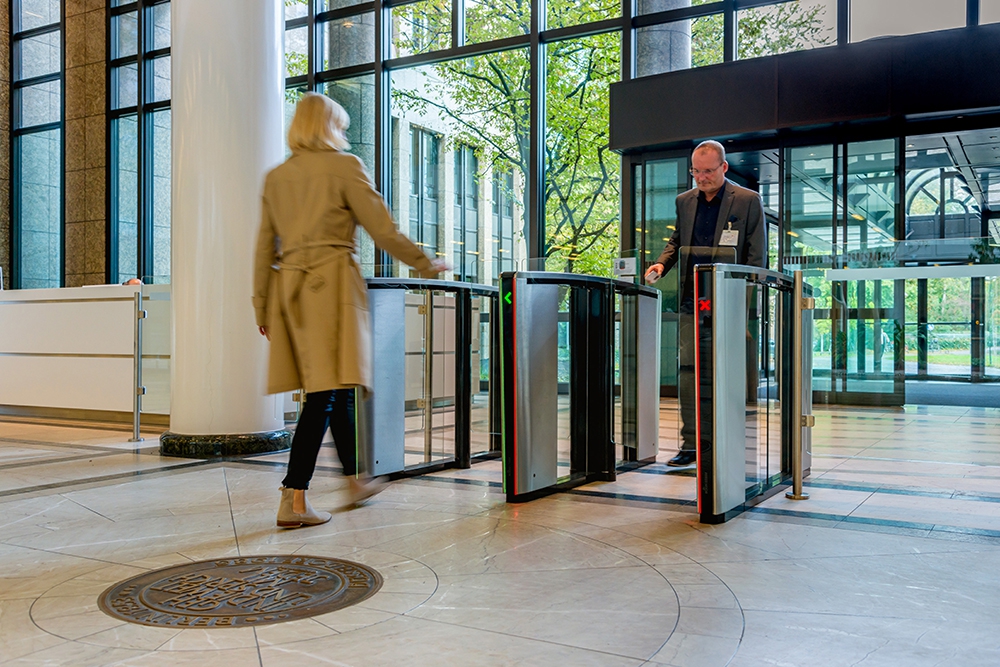Leveraging security entrances in the new age of hybrid workforces

By JC Powell, vice president of sales, Boon Edam
Updated 2:25 PM CST, Thu January 19, 2023

YARMOUTH, Maine—In March 2020, organizations across the globe sent their employees home not knowing when or how they would return. Almost three years later, many workplaces seem to have found their answer in a hybrid workforce.
Under a hybrid workforce model, organizations grant their employees the flexibility to work either from home or from the office. This schedule can be dynamic or consistent, with some employees scheduled to come into the office on certain days, and some on others. This kind of hybrid workforce has been championed as a part of the ‘new normal’ but has also introduced a number of new physical security challenges. It is here where secured entry solutions offer security integrators the opportunity to solve these challenges in a way that best meets the evolving needs of their customers.
The Effects of a Hybrid Workforce on Security
 For years, physical security solutions such as door hardware and legacy access control systems were seen as the preeminent means of securing facilities. Security integrators, too, have relied on such solutions to support their business model. However, these same solutions were not designed to meet the needs of a hybrid workforce.
For years, physical security solutions such as door hardware and legacy access control systems were seen as the preeminent means of securing facilities. Security integrators, too, have relied on such solutions to support their business model. However, these same solutions were not designed to meet the needs of a hybrid workforce.
When people come and go from a facility at different times and with different schedules, it is not enough to simply grant universal access. As the roster of employees who are authorized to be present on site may change every day, employers are looking for easier ways to manage access from a health-safety perspective. It is important that workers are issued fast, accurate access only for the times they need it while also guaranteeing limited physical access to spaces. Add visitors and vendors into the mix and the need for more stringent security measures increases even further.
Enter Secured Entry Solutions
Physical access control systems (PACS), when applied properly, can help install workflows that meet the needs of hybrid scheduling. The rise of touchless biometric and mobile credentialing has also helped authenticate identities and enable quick employee access post-pandemic. However, this is only half the story.
As an employee presents their credentials at a swing door, it is not uncommon for the employee to hold the door open for their colleague. This is especially true under hybrid working conditions where employees may or may not know their colleague has the proper permissions to be on-site that day. This basic social engineering scenario, known as tailgating, exposes a facility to the very undocumented and unauthorized entry that the PACS was designed to prevent. Any scheduling provisions put in place to handle a hybrid workforce are now negated. And while PACS can deter and detect such attempts, only secured entry solutions can actively prevent tailgating and other forms of unauthorized entry.
That is not to say PACS do not play an important role in a secured entry solution for a hybrid workforce. Security entrances that prevent unauthorized entry include security revolving doors and mantrap portals designed to prohibit unauthorized intrusion as it is attempted. Mantrap portals, for example, enforce single entry by using various sensor systems, including one that scans the compartment multiple times, confirming the authorized individual is alone and thus preventing all instances of unauthorized entry.
When intrusion prevention is of top concern, but maintaining high throughput is necessary, security revolving doors prevent tailgating attempts when [JC1] integrated with an access control system.
Security entrances, when coupled with a PACS, are one of the only ways to ensure consistent enforcement of any given access permissions provided under hybrid scheduling. Turnstiles, revolving doors, and mantrap portals are becoming more commonplace in facilities as a way to better manage their hybrid workforce. Such solutions can effectively limit the number of individuals in a building or even a specific area within a building. Furthermore, this access can be time based wherein access is limited to certain hours for each employee. The result is a solution that simultaneously reduces risk while making employees feel safer upon their return to work.
Implications for Security End Users
From a security integrator perspective, it is important to convey the value of secured entrances to an end user employing a hybrid workforce. This includes highlighting the benefits of unauthorized entry prevention and the ability to physically limit access as needed.
But there are many other benefits organizations can expect when deploying secured entrances, such as a greater ROI than that offered by PACS. For some organizations, this ROI can look like a reduction in personnel costs if guards were deployed to manually monitor and maintain employee entrances. For others, security entrances can be used as a great new source of business intelligence. The intelligence provided from these devices can help forecast and quantify an organization’s risk of infiltration and threat, leading to all-around better security throughout a facility.
Implications for Integrators
By offering secured entry solutions to address an end user’s hybrid workforce, systems integrators are afforded a new source of revenue that comes with inherently higher margins than those afforded by PACS alone. When integrated with an access control system, security entrances operate reliably to prevent unauthorized access, create a standard operating procedure, and gather context-rich data. The ability to offer clients a complete security solution comprised of a security entrance, PACS, and even other peripheral devices is a win-win for both integrators and end users in terms of added revenue and higher levels of system integration.
Integrators can also take advantage of the growth of hybrid workforces as a means to better grow their relationship with their customer. A security integrator that is better able to effectively understand the current needs of their customer and provide solutions that address new concerns is afforded a stronger relationship with their customers. As is the case with integrators communicating the value of secured entrances for hybrid workforces. The result is a mutually beneficial relationship that produces new, substantial revenue streams for years to come.
Now is the Time
A February 2022 Gallup poll asked 140,000 U.S. employees where they plan to work long term according to the plans their employer communicated. Remote-capable employees confirmed that a hybrid work schedule will be the predominant office arrangement going forward with 53 percent expecting a hybrid arrangement and 24 percent expecting to work exclusively remotely. This puts those offices with a fully in-person workforce in the minority at just 23 percent. Based on these results, now is the best time to communicate to security end users the value of secured entrance solutions for their hybrid workforce.
Comments